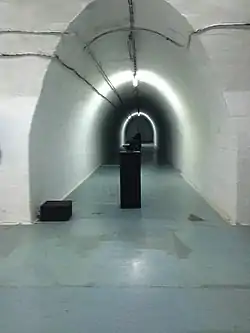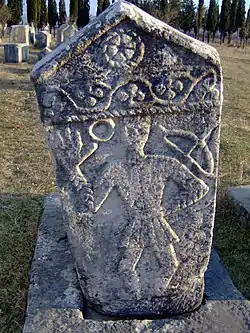Armijska Ratna Komanda D-0
The Armijska Ratna Komanda ARK D-0, (full civil designation Vojni objekat Armijska Ratna Komanda ARK D-0), (Cyrillic: Армијска Ратна Команда; English: Army War Command), also known as the Ark, ARK/D-0, Atomska Ratna Komanda, and nicknamed Tito's bunker,[3] is a Cold War era nuclear bunker and military command center located near the town of Konjic[4] in Bosnia and Herzegovina.[5] Built to protect Yugoslav President Josip Broz Tito and up to 350 members of his inner circle[3] in the event of an atomic conflict, the structure is made up of residential areas, conference rooms, offices, strategic planning rooms, and other areas.[5] The bunker remained a state secret until after the breakup of Yugoslavia in the 1990s.[6]
| ARK D-0 Armijska Ratna Komanda | |
|---|---|
| Konjic, Federation of Bosnia and Herzegovina, Bosnia and Herzegovina | |
 Main corridor inside ARK | |
| Coordinates | 43°38′03″N 17°59′42″E |
| Type | Cold War Nuclear bunker |
| Site information | |
| Owner | |
| Controlled by | |
| Condition | Operational (now museum) |
| Site history | |
| Built | 1953 - 1979[2] (Cost: $ 4.6 billion) |
| Built by | |
| Materials | Concrete and reinforced steel |
| Battles/wars | Cold War, Bosnian War |
| Language: Bosnian and Croatian (mutually intelligibile) | |
History
In 1953, as the Cold War was heating up, President Tito directed the Yugoslav People's Army (JNA) to begin work on the ARK bunker. In the event of nuclear war, the complex was designed to function as a center of military operations and a shelter for both the Supreme Command staff and Tito, along with his family and close associates. Its construction and existence were among the most closely guarded Yugoslav military secrets of the time[7] and remained so until the 1990s, when the ARK was revealed to the public.[5]
In 1979, when work was completed after 26 years and $4.6 billion in construction costs[3][7] (equal to $26 billion in today's currency[8]), the facility was handed over to a JNA detachment of 16 military personnel (by ethnicity: 9 Serbs, 4 Bosniaks, and 3 Croats)[6] tasked with maintaining the structure, should the need ever arise.
After Tito's death in 1980, the complex was mothballed but kept ready in case of war. In March 1992, during the breakup of Yugoslavia, the JNA ordered its demolition to deny it to the government of Bosnia and Herzegovina.
As with the nearby Željava Air Base, it was prepped for destruction with explosives, but the military detachment refused to carry out the order and instead surrendered the structure to the Bosnian government. It was subsequently used as a supply base by Republic of Bosnia and Herzegovina during the Bosnian War, as medical supplies and equipment were in short supply.
Construction
Built between 1953 and 1979[3][5] inside the Zlatar hill at the southern foothill of the Bjelašnica Mountain,[7] the ARK is the largest nuclear shelter,[4] and one of the largest underground facilities, ever built in the former Yugoslavia.[5] For over a decade after its completion, it was the most secret military installation in the country.[3] All construction workers were carefully selected and vetted, signing a contract of silence, and all staff members held the highest security clearance.[3]
Visible from the outside of the complex are three nondescript houses, not marked on any map, surrounded by natural settings and located along the Neretva River. For nearly 50 years, the houses concealed entrances to the third largest military facility in Yugoslavia (after the underground Željava Air Base near Bihać and the Lora naval facility in Split, Croatia).[3] The houses consist of a control residence, a building containing secure communication links, and the facility where technical support personnel would be located. Along a corridor located in the first house, three 1.20 meter-thick metal doors protect a tunnel leading to the heart of the shelter, which is 280 meters deep and 202 meters long.[3]
The underground horseshoe-shaped structure, built to withstand a 20-kiloton nuclear blast, is divided into interconnected 12 blocks, the most important being Blocks 6 (communication), 8 (Tito's block), 9 (air filtration), 10 (fuel storage), and 11 (water storage). Designed to protect and accommodate up to 350 people[5] for up to six months,[3] the bunker covers an area of 6,854 m² and contains over 100 rooms, including dormitories, two large conference rooms, five operation centers with direct phone links to the Presidency, two kitchens, five large toilets, a cryptography center, cable television access, and a fully equipped hospital operating room. President Tito's residence consists of five rooms: one for his secretary and party leaders, Tito's office, his bedroom, from which one could enter the room of Yugoslav First Lady Jovanka Broz, and a relaxation room.
Within the structure are 21 large systems and maintenance rooms[3] with containers capable of holding 50 tons of oil, climate control systems, 170 cubic-meter water tanks, and running water drawn from natural wells located within the mountain. Each system was equipped with a back-up in case the primary failed. The temperature in the bunker is between 21 and 23 degrees Celsius, with humidity between 60% and 70%, representing near-optimal subterranean living conditions. The complex is lit by approximately 6,000 neon bulbs.
Present
Today the facility is under the authority of the Bosnian Ministry of Defense and is managed by the country's military, guarded by a five-soldier detachment,[3] and preserved intact with all its symbols of the social, economical, political and ideological system of Socialist Yugoslavia. During the wars of the 1990s, many monuments in the former Yugoslavia were destroyed, particularly those in Bosnia and Herzegovina. ARK is therefore a unique exhibition space, a nontraditional artistic setting from both a psychological and intellectual point of view.[5]
ARK D-0 Underground Contemporary Art Biennial Project
Tito's bunker now serves as a meeting point for artists from across the region, Europe, and the world. The goal of the Project Biennial of Contemporary Art is to transform a site still officially under military control into a prestigious regional cultural institution at the forefront of emerging artistic trends.[9] The project seeks to preserve cultural heritage and a historic structure as well as to create artistic value and reestablish broken connections between artists and creative people in the region.
The Council of Europe in 2011 named the project a Cultural Event of Europe, and it also enjoys strong UNESCO support.[5] A first edition of the Biennial of Contemporary Art in 2011 brought together 44 artists from 18 countries and over 15,000 visitors.[3] Following a second edition in 2013, the opening of the third took place on 26 April 2015, when 35 artists from 19 countries presented their exhibits.[10] Over fifty works of art have remained on-site as permanent exhibits. The project has received financial support from Croatia, Bosnia and Herzegovina, Montenegro, Serbia, and Turkey.
Gallery
 Schematic view of ARK in Konjic
Schematic view of ARK in Konjic Room inside Tito's bunker near Konjic.
Room inside Tito's bunker near Konjic. Conference room in Tito's bunker near Konjic.
Conference room in Tito's bunker near Konjic. Communication center in ARK bunker near Konjic, Bosnia and Herzegovina.
Communication center in ARK bunker near Konjic, Bosnia and Herzegovina. Hallway inside ARK bunker near Konjic, Bosnia and Herzegovina.
Hallway inside ARK bunker near Konjic, Bosnia and Herzegovina. Light table and red phones inside command room in ARK bunker near Konjic.
Light table and red phones inside command room in ARK bunker near Konjic. Central telecommunications office inside Tito's bunker near Konjic, Bosnia and Herzegovina.
Central telecommunications office inside Tito's bunker near Konjic, Bosnia and Herzegovina.
| Wikimedia Commons has media related to Atomska Ratna Komanda. |
References
- "The Art Bunker". BBC.
- "Titov bunker ARK D0 - Konjic". Visitmycountry.net. Retrieved 2015-10-21.
- "ARK – najveće atomsko sklonište bivše Jugoslavije (VIDEO) – Sandžačke novine". Sandzacke.rs. Retrieved 2015-10-21.
- "D-0 ARK Biennial (Bosnia and Herzegovina)". Biennial Foundation. Retrieved 2015-10-21.
- http://wondersofnaturewith.blogspot.co.uk/2011/01/objekat-d0-konjic.html
- "ARK- Konjic". Hercegovina.ba. Archived from the original on 2015-09-16. Retrieved 2015-10-21.
- http://stojnic.co.uk/TitoBunker/
- "Contemporary Arts Biennale kicks off in Kojic". Balkan Insight. Retrieved 13 May 2013.
- "Atomska ratna komanda | AbrašMEDIA". Abrasmedia.info. 2013-04-23. Archived from the original on 2016-03-04. Retrieved 2015-10-21.
